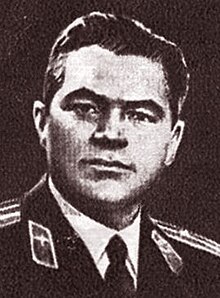Vostok 3

Model of the Vostok capsule with its upper stage
|
|||||
| Operator | Soviet space program | ||||
|---|---|---|---|---|---|
| Harvard designation | 1962 Alpha Mu 1 | ||||
| SATCAT № | 365 | ||||
| Mission duration | 3 days, 22 hours, 28 minutes | ||||
| Orbits completed | 64 | ||||
| Spacecraft properties | |||||
| Spacecraft | Vostok-3KA No.5 | ||||
| Manufacturer | Experimental Design Bureau OKB-1 | ||||
| Launch mass | 4,722 kilograms (10,410 lb) | ||||
| Crew | |||||
| Crew size | 1 | ||||
| Members | Andriyan Nikolayev | ||||
| Callsign | Сокол (Sokol - "Falcon") | ||||
| Start of mission | |||||
| Launch date | August 11, 1962, 08:24 UTC | ||||
| Rocket | Vostok-K 8K72K | ||||
| Launch site | Baikonur 1/5 | ||||
| End of mission | |||||
| Landing date | August 15, 1962, 06:52 UTC | ||||
| Landing site | 42°2′N 75°45′E / 42.033°N 75.750°E | ||||
| Orbital parameters | |||||
| Reference system | Geocentric | ||||
| Regime | Low Earth | ||||
| Perigee | 166 kilometres (103 mi) | ||||
| Apogee | 218 kilometres (135 mi) | ||||
| Inclination | 65.0 degrees | ||||
| Period | 88.5 minutes | ||||
|
|||||
Vostok 3 (Russian: Восток-3, Orient 3 or East 3) was a spaceflight of the Soviet space program intended to determine the ability of the human body to function in conditions of weightlessness and test the endurance of the Vostok 3KA spacecraft over longer flights. Cosmonaut Andriyan Nikolayev orbited the Earth 64 times over nearly four days in space, August 11–15, 1962, a feat which would not be matched by NASA until the Gemini program (1965–1966).
Vostok 3 and Vostok 4 were launched a day apart on trajectories that brought the spacecraft within approximately 6.5 km (4.0 mi) of one another. The cosmonauts aboard the two capsules also communicated with each other via radio, the first ship-to-ship communications in space. These missions marked the first time that more than one manned spacecraft was in orbit at the same time, giving Soviet mission controllers the opportunity to learn to manage this scenario.
Gherman Titov had suffered space sickness during his record-breaking one-day mission aboard Vostok 2. This condition was unknown at the time, leading Soviet scientists to devote efforts to study the effect of spaceflight on the human body.
...
Wikipedia


